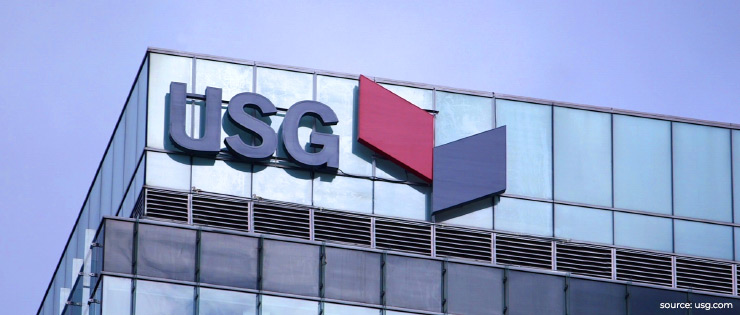Portfolio manager’s Letter March 2010
USG Corporation stock as high as $120.

Based on recent earnings reports, USG corporation could be classified a “dead man walking”. In 2008 the USG Corporation reported a loss of $4.67 per share. Then for 2009 they followed with a loss of $7.93 per share, and the casual observer might be justified in their belief that USG corporation had so much fun in bankruptcy that they have decided to try it again. However the negative earnings were mostly the result of non cash restricting charges and a look at the USG Corporation’s balance sheet gives us a somewhat different picture.
USG Corporation formerly US Gypsum Co. is the country’s largest producer of wallboard used in residential and commercial construction. USG corporation is also a leading provider of ceiling tile which is used mostly in commercial construction. As such, the USG corporation’s sales and earnings are dependent upon the cycles in commercial and residential construction. Obviously, the last few years have not been kind, and Mr. Market has been, you might say, egregiously abusive. From a high of $121 in April of 2006 USG fell to a low of $5.37 in February of 2009.
In June 2006 US Gypsum Co. emerged from a bankruptcy that was brought on by asbestos litigation just in time to deal with the worst housing market in since the end of WWII. With its exit from bankruptcy, USG had shed all potential asbestos liabilities, but was carrying $1.065 billion in short term debt and $1.439 billion in long term debt.
By the end of 2009, the short term debt had been paid off, while the long term debt had increased to $1.955 billion, so in the last three years, the USG corporation’s net debt has actually decreased by $549 million. At the same time, the USG corporation’s cash position has increased from $565 million in 2006 to $690 million in 2009. While the USG Corporation’s Income Statement has been bathed in red for the last three years ($1.173 billion total for the period), the balance sheet gives us a somewhat more sanguine picture, if USG Corporation can remain cash positive through the worst construction slump in post war US history, that (tends to have) (has) positive implications for the USG Corporation’s long term survival.
Berkshire Hathaway has maintained a long-term position in USG Corporation. The original position dates from the 4th quarter of 2000 when Buffett purchased 6.5 million shares for approximately $20 per share. In 2002, the USG Corporation entered bankruptcy to seek relief from legal problems related to asbestos.
In 2006, the USG corporation emerged from that bankruptcy. As part of the legal settlement, arranged by the bankruptcy court, the USG Corporation raised cash by selling stock to provide funds for a trust that would be responsible for any and all asbestos claims.
As part of the agreement for the offering, Berkshire Hathaway agreed, for a fee, to purchase any stock that was not sold through the offering. At the offering Berkshire Hathaway was able to purchase an additional 6,969,274 shares. After the offering, Berkshire Hathaway continued to buy stock in the open market for about $45 per share, and eventually raised its outright ownership to 17 million shares. In October 2008, Berkshire Hathaway purchased $300 million of 10% convertible senior notes that can be converted into 26.4 million shares at $11. This conversion would leave Berkshire Hathaway with a total of 43.4 million shares or 31% of the outstanding shares.
At that time I suspected that Buffett would by the whole company because USG Corporation fits very nicely with Berkshire Hathaway’s building material companies. This, I suspect, is part of what we will call Buffett’s hurricane synergy. This is the idea that, if Berkshire Hathaway can buy enough companies in the building materials, construction, and manufactured housing industries, then, when its insurance companies are paying insurance claims for catastrophic damage due to hurricanes and earthquakes, Berkshire Hathaway, as a company, will just be transferring money from one pocket to another.
Losch Management Company have no way of knowing if this is what Buffett has in mind, but it is hard for me to think of a company that fits this pattern better than one that makes wallboard and ceiling tile. At this point, it looks like Berkshire Hathaway may have backed off increasing its stake in USG Corporation. In that they could have bought stock below $10, but passed. Or, perhaps Buffett passed just because there were so many other goodies to pick from.
USG Corporation’s best year so far was 2004 when it earned $5.62 per share, and in 2006 the stock traded as high as $120. Assuming even a modest recovery in the housing sector today’s price of $14 looks cheap in relation to recent history. Of course, with the current surplus of housing in this country, the company is not likely to get back to its prior level of earnings any time soon. On the other hand, the economics reality is that in a severe economic contraction, the survivors gain just by surviving.
USG Corporation was an industry leader before the correction, and should be able to increase their dominance in a recovery. In a recession, weaker competitors fail, capacity is removed, manufacturing plants are shut down, and people are laid off. When there is a recovery and demand increases, buyers can face tight supply and the surviving suppliers can easily raise prices and increase profits. In his Chairman’s letter, Buffett said that he expects the housing unit surplus will be worked off by the end of the year. This could be good news for USG Corporation. It still may be too early to buy, but if you wait for the cheery consensus … well you know.
Blog Archive
